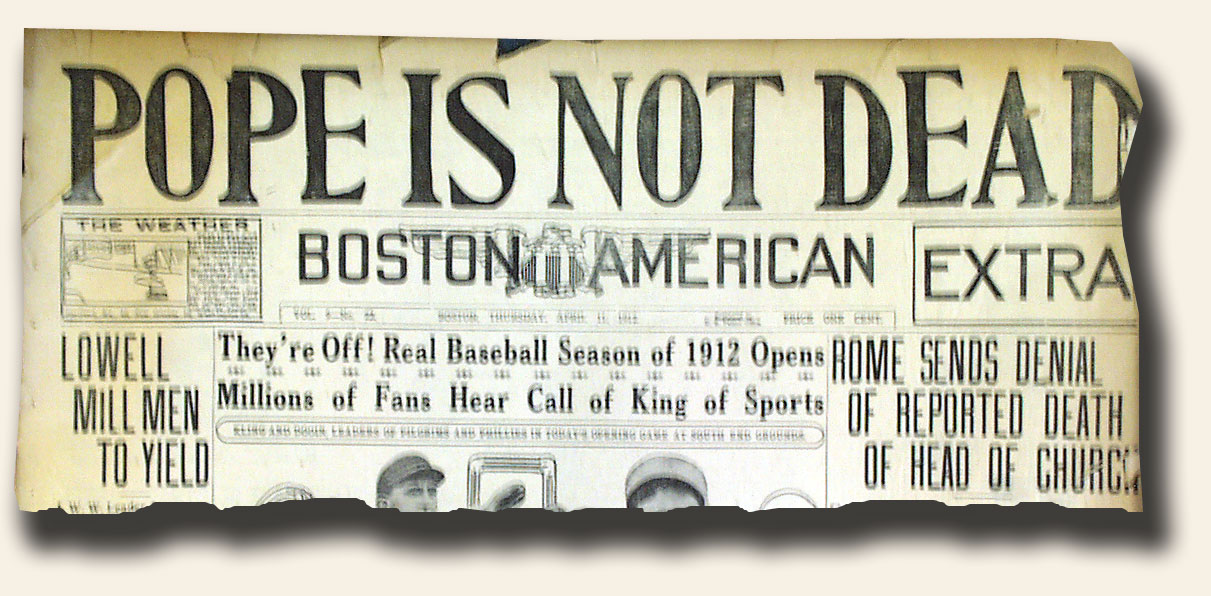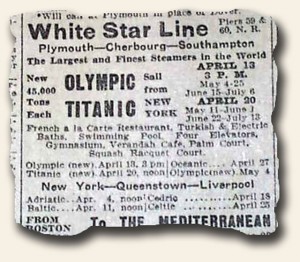From the Vault: Best of the 20th century?
April 10, 2023 by GuyHeilenman · Leave a Comment
As newspaper collectors we dream of “the event” we’d like to add to our collection. It’s the search for that issue–or issues–which make this a fascinating hobby. This is, after all, a very visual hobby. How displayable are stamps and coins? Huge headlines proclaiming a cataclysmic event or magnificent achievement lend themselves so well to display, much more so than an original document about the event.
The 20th century had a great wealth of interesting events. But what is the best? If you could only make one choice, what single headline of the 20th century would you most want to see in your collection?
I wrestle with how to approach this thought: most life-altering? most recognizable? most historic? most appealing for display? I believe the first Wright brothers‘ flight is the most life-altering; “Dewey Defeats” Truman” as the most recognizable; and a great “Titanic Sinks” report as the most displayable. Some newspapers did much with the events of the gangster era, and certainly the “careers” of Bonnie & Clyde, John Dillinger and Al Capone are well known and significant reports would be attention-grabbers on any wall. On a more positive note there are some spectacular “V-E Day” and “V-J Day” issues celebrating the end of World War II. But limiting myself to just a single issue I would take “Titanic Sinks”. ….what’s your thought?
Note: The History’s Newsstand Blog went live for the first time in 2008. Since then our goal has been to provide informative of interest to both novice and well-oiled collectors of Rare & Early Newspapers. The focus of the “From the Vault” series is to introduce the current generation of collectors to posts from the past (with occasional updates as appropriate). The original post shown above can be viewed at:
It’s All About the Headline…
November 5, 2022 by Laura Heilenman · Leave a Comment
Some of our collectors are drawn to a poignant political speech and some are passionate about 17th – 19th century maps. More than a few seek reports of famous battles while others can’t resist death reports of notable generals. When it comes to the Rare & Early Newspapers collectible, breadth of interest runs from the heart-wrenching past (illustrated slave ads – lest we forget), to the lighthearted (a recent issue containing an ad & review of a favorite movie. However, regardless of their interest, for a majority of collectors it’s all about the headline – the more frameable and dramatic, the better!
 With this in mind, may I submit as an example the banner headline of Hearst’s Boston American for April 23, 1906: “SAN FRANCISCO SUFFERERS GO MAD! “, followed by: “Crazed By Horrors They Roam The Streets”. Can we all agree… even the tabloids of today can’t touch this! So, whether you are drawn to the macabre, the triumphant, or merely the historical, for many it’s all about the headline. After all…
With this in mind, may I submit as an example the banner headline of Hearst’s Boston American for April 23, 1906: “SAN FRANCISCO SUFFERERS GO MAD! “, followed by: “Crazed By Horrors They Roam The Streets”. Can we all agree… even the tabloids of today can’t touch this! So, whether you are drawn to the macabre, the triumphant, or merely the historical, for many it’s all about the headline. After all…
GREAT HEADLINES SPEAK FOR THEMSELVES
The Day the Music Died? Mother Theresa dies… Princess Diana is laid to rest…
August 24, 2017 by GuyHeilenman · 3 Comments
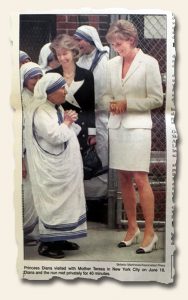 On February 3, 1959, Buddy Holly, Ritchie Valens, and the Big Bopper died in a plane crash shortly after takeoff, and inspired one of the most recognizable tunes of all time: American Pie (Bye, bye Miss American Pie), by Don Mclean – a song he says was inspired by his reaction to reading the account of the crash in the morning paper. Fast forward nearly 20 years to the morning paper for September 6, 1997, and one can only imagine the emotions evoked by the duel headlines: “The World Mourns Diana” and “Revered Mother Teresa Dies”. Two people – one young, one old… one living in abundance, one living in squalor… one with the soft skin of a new-born babe, one with wrinkles upon wrinkles… one incredibly rich, one overwhelmingly poor – yet both committed to making a difference in the lives of the needy… the infirm… the neglected… the destitute. In the blink of an eye, both passed into eternity, leaving a mantle just begging to be picked up by those whose lives they had touched.
On February 3, 1959, Buddy Holly, Ritchie Valens, and the Big Bopper died in a plane crash shortly after takeoff, and inspired one of the most recognizable tunes of all time: American Pie (Bye, bye Miss American Pie), by Don Mclean – a song he says was inspired by his reaction to reading the account of the crash in the morning paper. Fast forward nearly 20 years to the morning paper for September 6, 1997, and one can only imagine the emotions evoked by the duel headlines: “The World Mourns Diana” and “Revered Mother Teresa Dies”. Two people – one young, one old… one living in abundance, one living in squalor… one with the soft skin of a new-born babe, one with wrinkles upon wrinkles… one incredibly rich, one overwhelmingly poor – yet both committed to making a difference in the lives of the needy… the infirm… the neglected… the destitute. In the blink of an eye, both passed into eternity, leaving a mantle just begging to be picked up by those whose lives they had touched.
What about you? What about me? Truth be told, we’re all just Candles in the Wind. What acts of kindness, goodness, and humble service are filling our days while our candles are still burning? Stirred emotions can be a salve for the soul if they lead to action. Have you picked up their mantel? Have I? Who among us is selflessly helping those who are unable to help themselves?
Yet another set of heart-challenging thoughts (questions) ran through my mind as my damp eyes leafed through the pages of The Arizona Republic (September 6, 1997), passed over the various images of Princess Di and Mother Teresa, absorbed the printed lyrics of The Candle in the Wind (by Elton John), and settled on the photo of the two, together, only months prior to their deaths:
What song does Mother Teresa get? Princess Di gets “A Candle in the Wind”, and the Buddy Holly, Ritchie Valens, and the Big Bopper get “American Pie”, but what about Mother Teresa? Who sings for her? And the 2nd question…
If February 3, 1959 is The Day The Music Died, then what is September 6th (or 5th), 1997? I’d love to know your thoughts.
Seeking the best of the 20th century…
May 23, 2014 by TimHughes · Leave a Comment
 The introduction to collecting old newspapers for most typically comes through finding a newspaper of recent past with a headline remembered from history class. They turn up in flea markets, garage sales, and attics, but wherever the discovery, there is a fascination which—for many—begins a quest to find more and better.
The introduction to collecting old newspapers for most typically comes through finding a newspaper of recent past with a headline remembered from history class. They turn up in flea markets, garage sales, and attics, but wherever the discovery, there is a fascination which—for many—begins a quest to find more and better.
Of the five centuries from which old newspapers can be found, the 20th century has one distinct advantage and that is displayability. It was just before the turn of the 20th century that newspaper competition was rampant in the United States and bigger and bigger headlines became one method of grabbing attention over a competitor’s newspaper on the corner newsstand. Headlines from the Spanish-American War of 1898 were often large and dramatic, and that format carried well into the 20th century. Although the aim was to sell more newspapers, the unintended long-term consequence was to intrigue the collector with an enticing headline that would look great on display.
I will touch on some of the more notable events of the 20th century, in chronological order, which may present a “checklist” of events which would be great additions to any collection.
Their can be little question that the oil industry transformed the American landscape, and the first major discovery happened at the beginning 20th century with the Spindletop well near 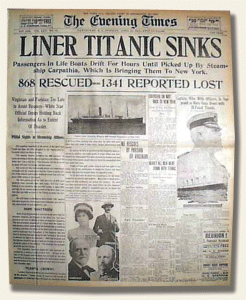 Houston. Just two years later the Wright brothers would make history with their first powered flight, again an event which would transform that way the entire world lives. The first major natural tragedy would be the San Francisco earthquake of 1906, and many newspapers provided graphic details.
Houston. Just two years later the Wright brothers would make history with their first powered flight, again an event which would transform that way the entire world lives. The first major natural tragedy would be the San Francisco earthquake of 1906, and many newspapers provided graphic details.
The sinking of the Titanic was the next major tragedy which dominated the headlines for not just a day but for several weeks, and newspapers did much to dramatize the event & its investigation. While some newspaper maintained a very conservative format, others sported full banner headlines in bold type with illustrations and photos to make for an appealing front page. Just 3 years later the sinking of the Lusitania would receive similar response by newspaper publishers across the country.
World War I made headlines in American newspapers beginning in 1915, but it was America’s entry in the war in 1917 that would spark more detailed coverage of the war that would end in 1918. News of the armistice ending the war would result in some of the largest & most dramatic headlines to appear in newspapers up to that time.
Following the war, baseball would enter its golden era when Babe Ruth came on the scene, he becoming one of the first of the major stars of the 20th century and capturing headlines in newspapers across the country. But just prior to his hay-day was the infamous “Black Sox” 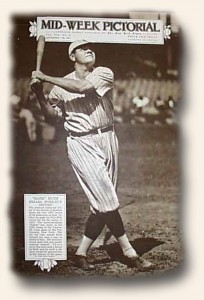 scandal of the Chicago White Sox, with charges of fixing the 1919 World Series games involving several Chicago players. But those headlines would soon be supplanted by the exploits of Ruth as his record-breaking streak added much excitement to the game of baseball and newspapers were only too happy to comply with considerable coverage. Other stars would find prominence as well, including fellow Yankees Lou Gehrig & Joe DiMaggio, and later on Ted Williams & Jackie Robinson among the more notable.
scandal of the Chicago White Sox, with charges of fixing the 1919 World Series games involving several Chicago players. But those headlines would soon be supplanted by the exploits of Ruth as his record-breaking streak added much excitement to the game of baseball and newspapers were only too happy to comply with considerable coverage. Other stars would find prominence as well, including fellow Yankees Lou Gehrig & Joe DiMaggio, and later on Ted Williams & Jackie Robinson among the more notable.
Charles Lindbergh’s accomplishment of being the first to fly solo across the Atlantic caused him to be one of the most famous men in the world at the time, and newspaper coverage was exceptional. But shortly after his 1927 flight the gangster era came to the attention of newspaper, the St. Valentine’s Day massacre of 1929 being one of the first major events to find front page coverage across the country. This fascinating era would extend into the mid-1930’s and names such as Al Capone, John Dillinger, “Baby Face” Nelson, “Legs” Diamond and “Dutch” Schultz were commonly found on front pages.
The stock market crash of 1929 would trigger the Great Depression, which affect the entire nation in so many ways. Collectors look for the most dramatic wording in such a headline, with “Crash” “Tragedy” and similar cataclysmic words making for desirable collector pieces.
Other sports and sports stars would come to prominence in newspapers of the day, including golfer Bobby Jones and his Triple Crown accomplishment in 1930; Phar Lap, one of the 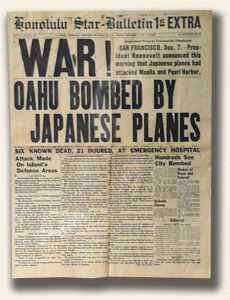 more famous race horses of the 20th century; Jim Thorpe and his Olympic and football prowess; Jesse Owens at the 1936 Olympics, World Cup soccer, Notre Dame football, boxing greats Jack Johnson, Jack Sharkey, Max Schmeling & Joe Louis commanding headlines, and so much more. There was such extensive coverage of sports in the 20th century that many build huge collections with this singular theme.
more famous race horses of the 20th century; Jim Thorpe and his Olympic and football prowess; Jesse Owens at the 1936 Olympics, World Cup soccer, Notre Dame football, boxing greats Jack Johnson, Jack Sharkey, Max Schmeling & Joe Louis commanding headlines, and so much more. There was such extensive coverage of sports in the 20th century that many build huge collections with this singular theme.
Perhaps the most defining event of the 20th century was World War II, begun with the ascendency of Adolf Hitler and the Nazi party in Germany and his invasion of Poland in 1939. With America’s entry in the war upon the attack on Pearl Harbor, barely a single newspaper for the next 4 ½ years would be devoid of war coverage. Because such issues were commonly saved and found in attics by their children, collectors pursue only the most major events and with the largest headlines. Tops of the list would be Pearl Harbor, battle of Midway, the D-Day invasion, the death of Hitler, the end of the war in Europe, the dropping of the atomic bomb, and the end of the war in the Pacific. Many tabloid-size newspapers had the entire front page consumed by headlines, lending themselves to displayability, particularly given their smaller size.
The Korean War would begin the 1950’s, and would be followed by events of the Cold War. At the end of the decade music would begin making some headlines, led by Elvis Presley and more tragically with the airplane death of Buddy Holly & Richie Valens. A few years later the Beatles would come on the scene to define the music world for the 1960’s.
 Politics always made headlines in the 20th century which began with McKinley and ended with Bill Clinton, but perhaps the most collectible political person would be John F. Kennedy. His assassination –the second of the 20th century–stunned the world , and some headlines were extremely dramatic. Always the “best of the best” would be newspapers from where the event happened, so it is no surprise that Dallas newspaper reports on the JFK assassination draw the most interest.
Politics always made headlines in the 20th century which began with McKinley and ended with Bill Clinton, but perhaps the most collectible political person would be John F. Kennedy. His assassination –the second of the 20th century–stunned the world , and some headlines were extremely dramatic. Always the “best of the best” would be newspapers from where the event happened, so it is no surprise that Dallas newspaper reports on the JFK assassination draw the most interest.
Although the space era began as early as 1928 with the work of Robert Goddard, it was the success of Sputnik & the resulting space race in the late 1950’s that would captivate the headlines. America made its mark in the early 1960’s with Alan Shepard and John Glenn, culminating in 1969 with the landing of men on the moon & their safe return.
Scattered throughout the 20th century are many memorable names which made the occasional headline, including Mark Twain, Thomas Edison, Houdini, Albert Einstein, Rudolph Valentino & Walt Disney to name but a few.
Regardless what events or themes a collector might pursue from the 20th century the challenge is to find the most dramatic and impactful report. Large headlines command a premium, and when photos or graphics accompany a headline it only adds to the appeal. Collectors know some great headline reports are lurking out there just begging to be found. The thrill is finding them, and make them prized additions to their collection.
#25 – Best of the 20th century? (*revisited)
January 3, 2014 by GuyHeilenman · Leave a Comment
As newspaper collectors we dream of “the event” we’d like to add to our collection. It’s the search for that issue–or issues–which make this a fascinating hobby. This is, after all, a very visual hobby. How displayable are stamps and coins? Huge headlines proclaiming a cataclysmic event or magnificent achievement lend themselves so well to display, much more so than an original document about the event.
The 20th century had a great wealth of interesting events. But what is the best? If you could only make one choice, what single headline of the 20th century would you most want to see in your collection?
I wrestle with how to approach this thought: most life-altering? most recognizable? most historic? most appealing for display? I believe the first Wright brothers’ flight is the most life-altering; “Dewey Defeats” Truman” as the most recognizable; and a great “Titanic Sinks” report as the most displayable. Some newspapers did much with the events of the gangster era, and certainly the “careers” of Bonnie & Clyde, John Dillinger and Al Capone are well known and significant reports would be attention-grabbers on any wall. On a more positive note there are some spectacular “V-E Day” and “V-J Day” issues celebrating the end of World War II. But limiting myself to just a single issue I would take “Titanic Sinks”. ….what’s your thought?
*The Fall of 2013 marked the 5th anniversary of the History’s Newsstand Blog by Timothy Hughes Rare & Early Newspapers. We are grateful to have the opportunity to contribute to the newspaper collecting community, and appreciate those who have participated through guest posts, comments, and readership. In 2014 we will revisit the top 25 posts (measured by activity), with the number 1 post being revisited during the first week of 2015. Please enjoy. If you would like to contribute a post for consideration of inclusion on the blog, please contact Guy Heilenman at guy@rarenewspapers.com.
Why I Still Read Newspapers… part 3 of 3… perhaps with more forthcoming???
November 9, 2012 by GuyHeilenman · Leave a Comment
A staff member at Timothy Hughes Rare & Early Newspapers recently received a set of newspaper headlines which are worth pondering. We’ve decided to split them up over a few posts… this being the final of the initial set – with perhaps more to come??? If you know of others – appropriateness is a must 🙂 – please send them on (e-mail to guy@rarenewspapers.com) and we will consider adding them to a future post. If you would like to receive credit, please include your name. Please enjoy:
Why I Still Read Newspapers… part 2 (of 3)
November 3, 2012 by GuyHeilenman · Leave a Comment
A staff member at Timothy Hughes Rare & Early Newspapers recently received a set of newspaper headlines which are worth pondering. We’ve decided to split them up over a few posts… this being the 2nd of three. If you know of others – appropriateness is a must 🙂 – please send them on (e-mail to guy@rarenewspapers.com) and we will consider adding them to a future post. If you would like to receive credit, please include your name. Please enjoy:
Why I Still Read Newspapers… part 1 (of 3)
October 26, 2012 by GuyHeilenman · Leave a Comment
A staff member at Timothy Hughes Rare & Early Newspapers recently received a set of newspaper headlines which are worth pondering. We’ve decided to split them up over a few posts. If you know of others – appropriateness is a must 🙂 – please send them on (e-mail to guy@rarenewspapers.com) and we will consider adding them to a future post. If you would like to receive credit, please include your name. Please enjoy:
The Titanic… and newspapers…
April 11, 2012 by TimHughes · 2 Comments
Few newspapers in 20th century world history are more desired that those which report the sinking of the Titanic. The combination of the scale of the tragedy, it being the maiden voyage of the world’s largest ship, it claiming to be unsinkable, and the loss of some of the wealthiest & more famous names in America, all combine to make for a desirable event. And add to this the tremendous success of the 1997 movie and interest explodes. We find that interest is piquing once more with the re-release of the successful movie, which begs the question: Just what do collectors desire most in this report?
From comments by collectors and what they pay for the best we have offered through the years, the “best of the best” would include:
* As huge a headline as possible. Type with letters 3 issues tall are more dramatic & displayable than those with letters half an inch tall.
* The words “Titanic” and “Sunk” somewhere within the headline. The more dramatic the headline the better.
* A banner headline–which stretches from edge to edge–rather than a two column headline. For many newspapers that was simply not their format. But banner heads have always been more desired than small headlines.
* Not necessarily first reports. Many reports dated April 15 tended to have sketchy reports, smaller headlines, and inaccurate statements. Several noted that the Titanic was being safely towed into port. Issues dated April 16–when more accurate information was known–tended to be not only more historically correct but more dramatic as well.
* Best condition possible. Those which came from bound volumes tend to be in great condition since they were protected within the volume for 100 years. Never-bound issues tend to suffer from wear and staining.
* Complete issues only. Front pages only might be fine for display but maximum desirability is only for issues with all published pages.
* A graphic. Some newspapers used a pre-existing photo of the Titanic. But of more interest are artists’ renditions of what the sinking may have looked like. Some were very dramatic. The larger the better.
* Famous titles such as the New York Times, Chicago Tribune, etc. tend to have more desirability, but a dramatic presentation will always trump a famous title.
Note: To view a selection of Titanic disaster headlines on Pinterest, go to:
The Titanic Sinks – Historic Newspapers
Reporting a non-event…
July 2, 2011 by TimHughes · Leave a Comment
It must have been a very slow news day as the “Boston American” of April 11, 1912 has a bold headline (see below) proclaiming a non-event (see). Ironically, this was also the day after the Titanic set sail for its maiden voyage. Four days later the headline would be extremely significant.